Winter Hiking Gear Essentials—How to Dress to Stay Warm and Safe!
This post may contain affiliate links.
Hiking season doesn’t have to end with the arrival of winter. With the right winter hiking clothes, you can enjoy your favorite day hiking trails all year round! In this post, we’re sharing the essentials that helped us embrace winter and actually look forward to cold-weather hiking.
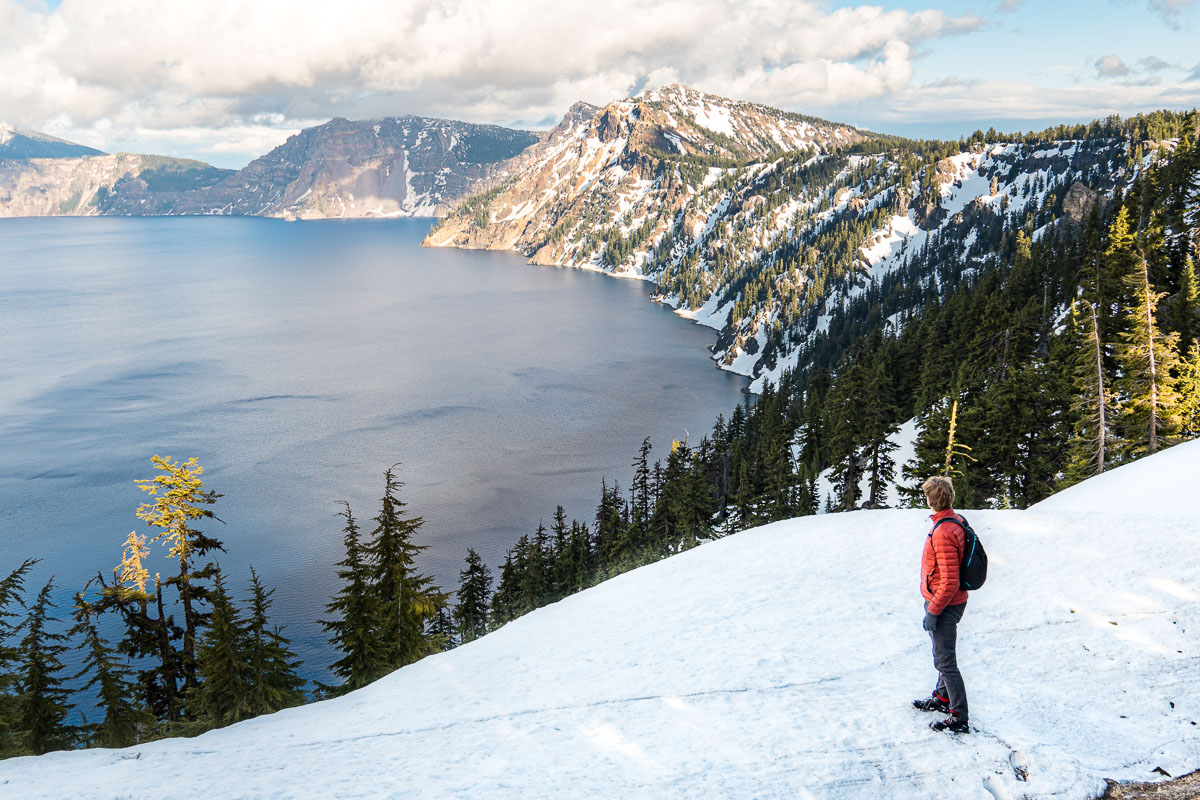
There’s a Scandinavian expression we love: “There’s no bad weather, only bad clothing.” For years, we dreaded winter—mostly because we didn’t know how to layer properly. So we would grit our teeth to get through the darker days until we could hike again in the spring.
But once we invested in the right winter hiking gear, everything changed. It is no exaggeration to say having the right clothes reshaped our relationship with winter. Now, winter hiking has become one of our favorite outdoor experiences that we look forward to every year!
In this post, we’ll cover the basics of layering, tips for staying warm and dry, and offer our recommendations for our favorite cold-weather hiking gear.
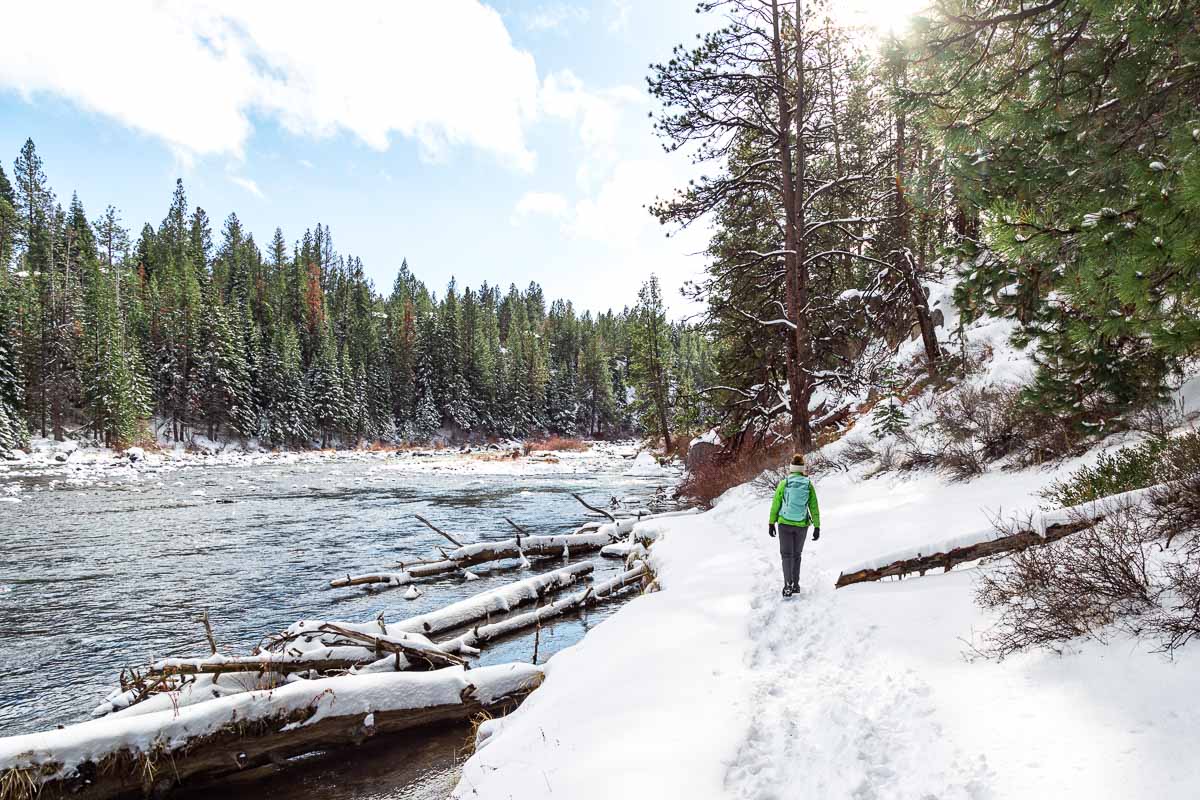
The number one rule of winter hiking: Stay dry!
Winter clothing needs to keep you both warm and dry—staying dry is critical. Cold and wet conditions rapidly lower body temperature, as water cools you 25 times faster than air1, which can quickly become dangerous.
There are two main ways to get wet: outside and inside. External sources include rain, melting snow, ice, or puddles. Waterproof layers will block this external moisture.
The less obvious risk is internal moisture from sweat. Overheating can lead to sweat, which cools your body fast once you stop moving. Aim to stay comfortably warm without overheating by adjusting your layers based on exertion levels. This brings us to our next point…
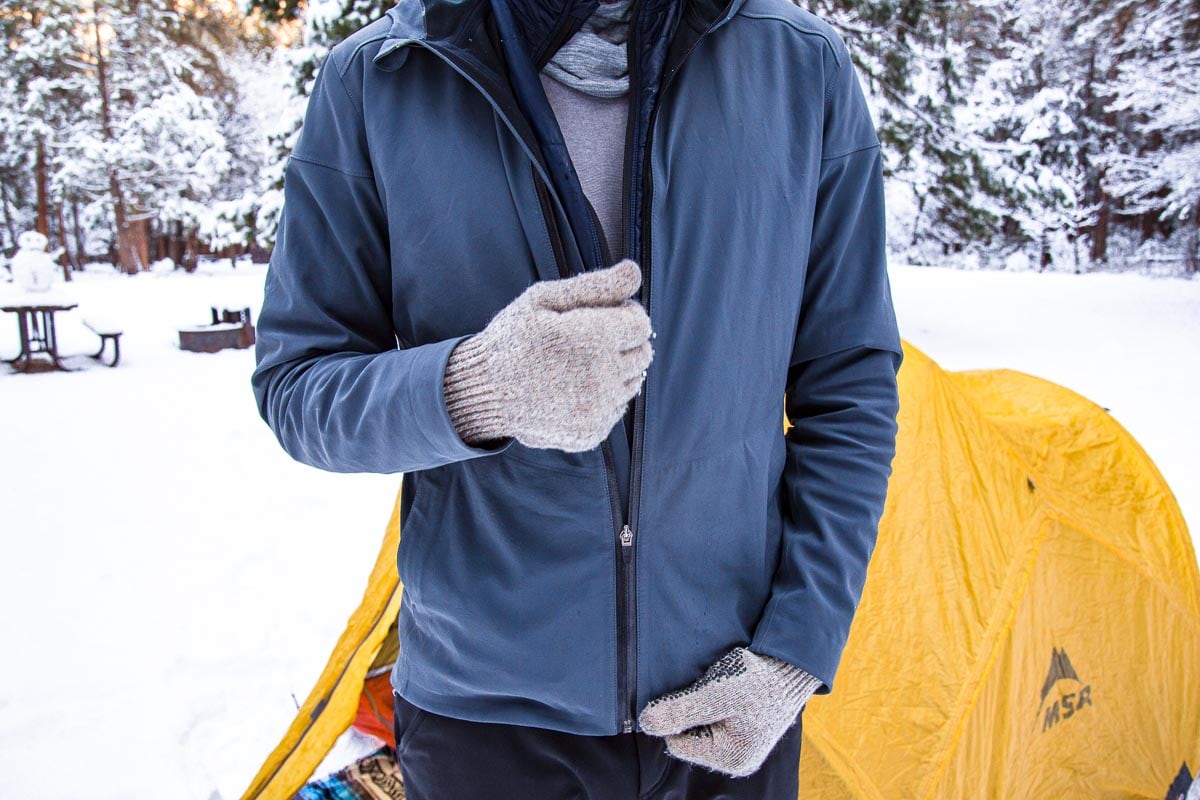
Layering for Cold Weather Hiking
Layering is the foundation for staying comfortable in any winter activity. Adjusting layers helps you match your exertion level to stay warm without overheating. Here are the basics–we’ll go into further details in the sections below!
- Base Layer: This traps heat close to your body and wicks away moisture if you sweat.
- Mid-Layer: This provides most of your insulation by trapping your body heat to retain warmth.
- Outer Shell: A waterproof, windproof shell protects against moisture and wind, which can accelerate cooling.
The layering tip everyone forgets: Keep Adjusting!
Layering isn’t a “set-it-and-forget-it” system. As soon as you feel too warm, stop to adjust—unzip, push up sleeves, or remove a layer. If you start feeling chilly, add a layer—staying warm is easier than regaining warmth.
Frequent adjustments are key, especially on varied terrain. Also, have a large daypack to store extra layers—without one, you might be tempted to keep layers on and overheat.
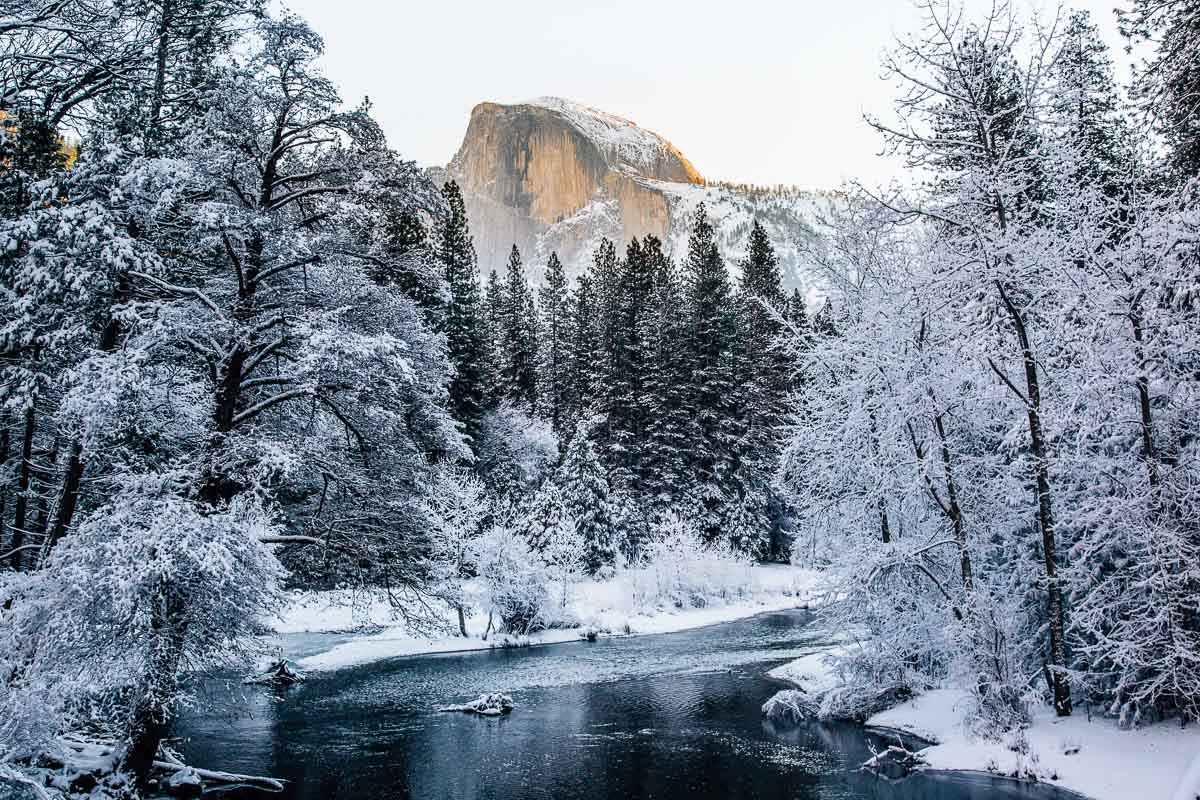
What to wear hiking in winter
Layers are key for staying comfortably warm and dry while hiking in the winter. In these sections, we’ll cover all the different winter hiking layers, as well as our tried and true favorite pieces to point you in the right direction.
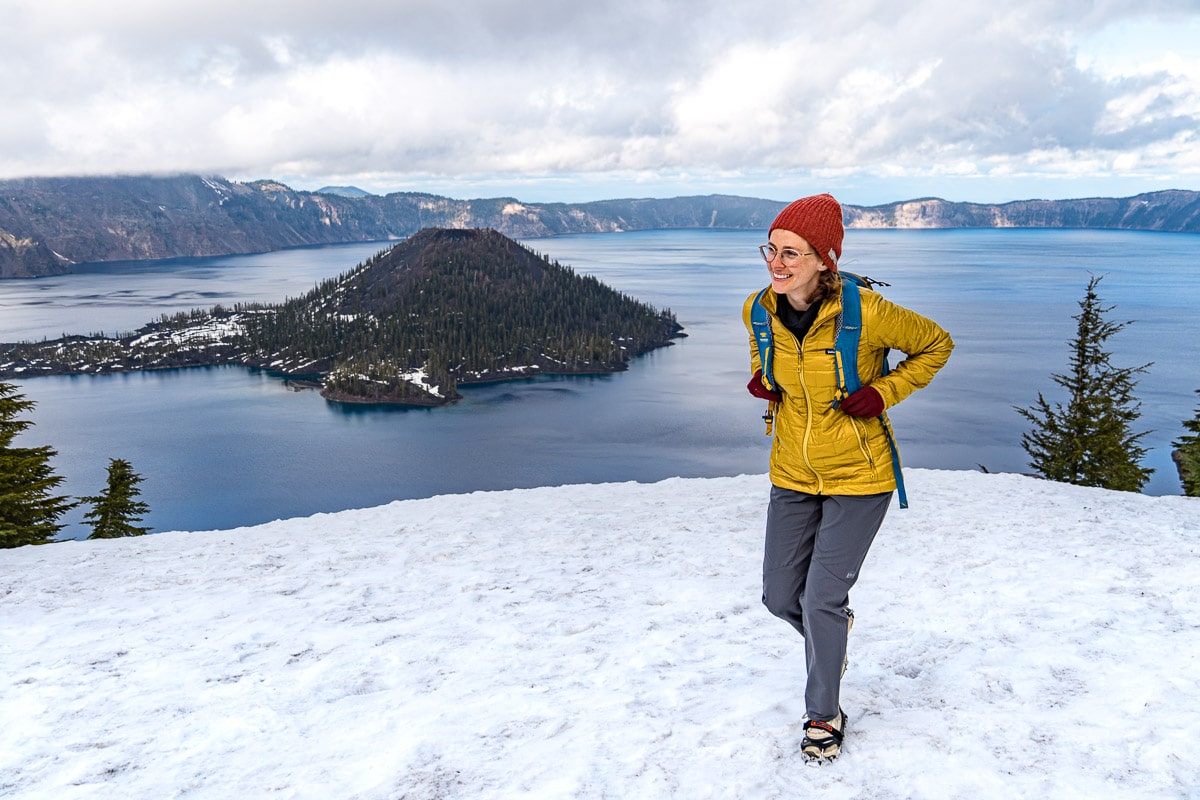
Winter Hiking Jackets, Shells, and Baselayers
Base Layer Top
A good base layer traps heat, wicks moisture, and should be soft, cozy, and close-fitting. Opt for merino wool or synthetics—avoid cotton. Wool resists odors, while synthetics dry faster.
Tried & True Favorites
Insulating Mid Layer(s)
Midlayers are where the bulk of your insulation will come from, trapping your body heat to keep you warm. It’s usually a good idea to pack two midlayers that you can layer as needed: a fleece-type jacket and a down or synthetic insulating jacket.
Our Favorite Fleece Jackets
Tried & True Insulating Jackets
Outer Layer Shell Jacket
A weatherproof shell blocks external moisture and wind. For winter hikes, we usually choose a rain jacket as our shell. Look for synthetic, waterproof materials with stretch fabric, zipper vents, and an adjustable hood. Ensure it’s roomy enough to fit over your mid-layer—consider sizing up if needed.
In our closet
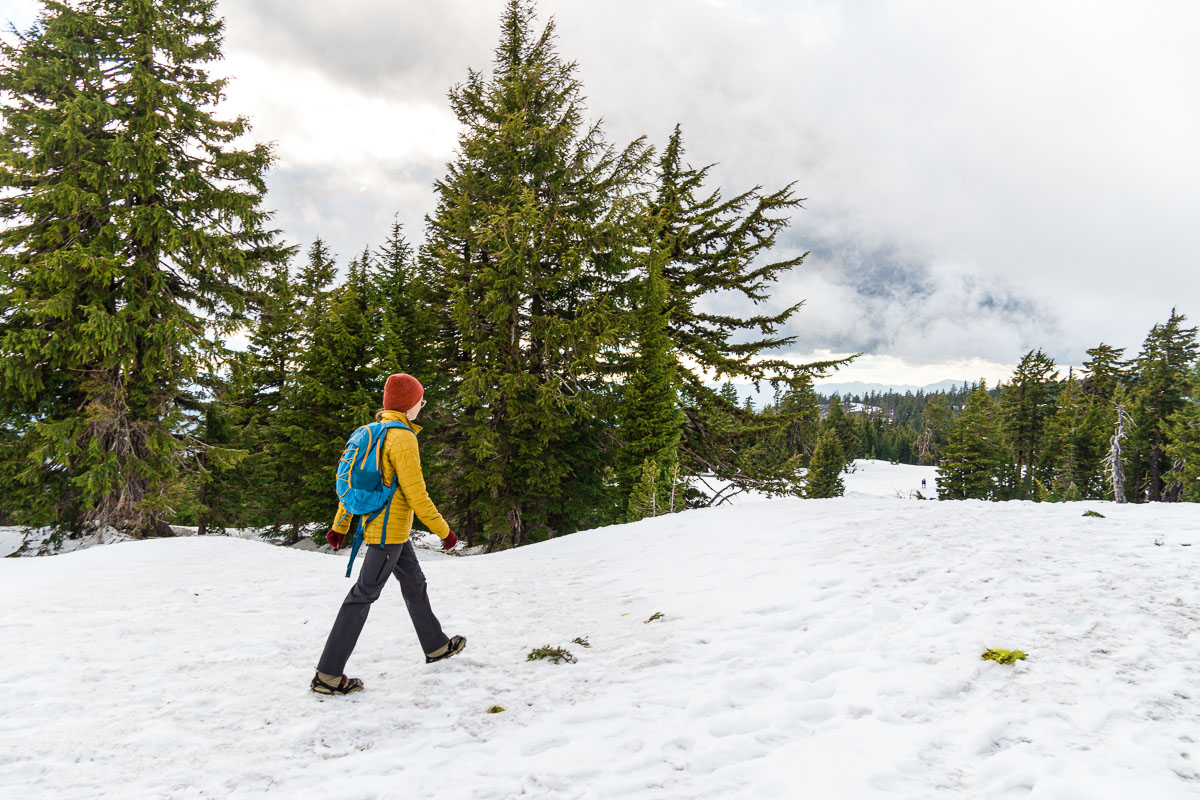
Winter Hiking Pants and Baselayers
Base Layer Bottoms
Like baselayer tops, your baselayer bottoms are meant to help wick sweat and trap heat next to your skin. (If I’m wearing leggings—see below—I will typically skip this layer.)
In our closet
Winter Hiking Pants/Leggings
A good pair of winter hiking pants should be, at a minimum, water and wind-resistant. A few of the pants I like and recommend below are fleece-lined as well, providing a little extra warmth!
Favorite Winter Leggings
Favorite Winter Hiking Pants
Outer Shell
If your hiking pants aren’t waterproof, you’ll want to pack a waterproof shell pant to keep snow and/or rain off of you. Remember, the name of the game is staying dry! These could be rain pants that go over your hiking bottoms, or if the weather calls for it, a pair of snow pants (with a base layer underneath).
Top Pick
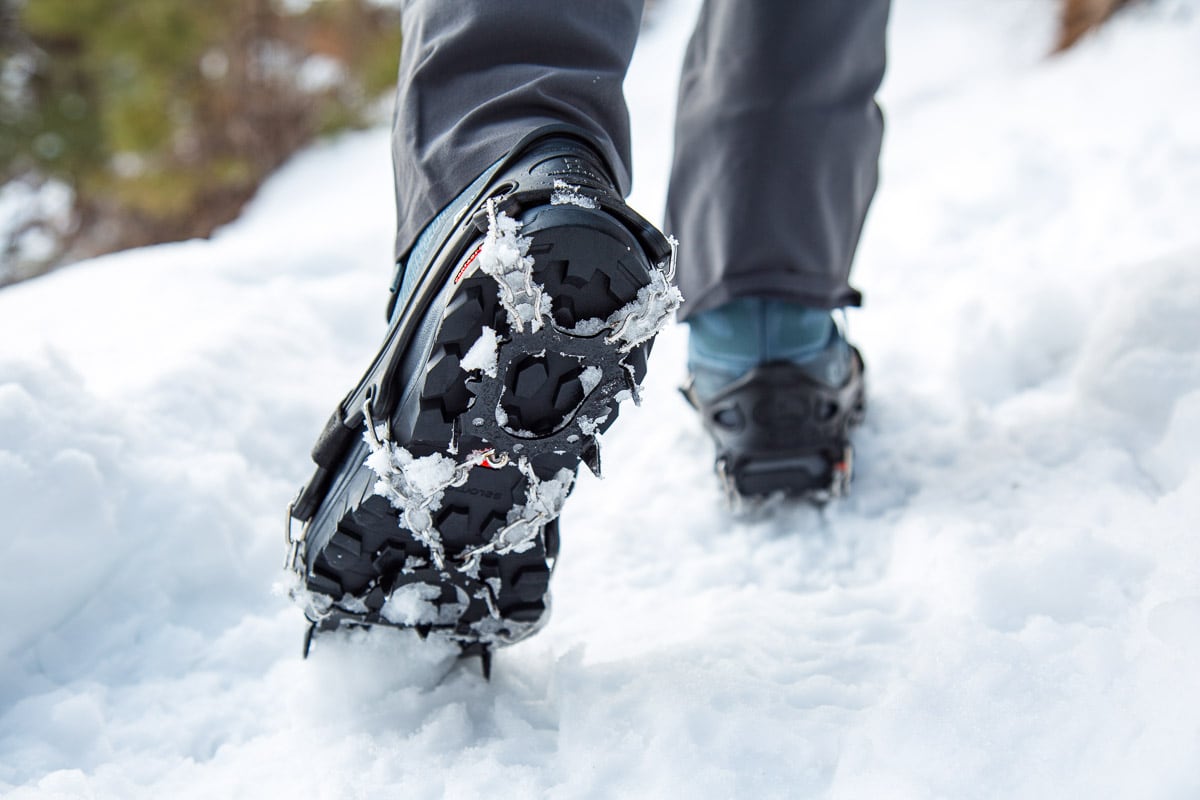
Winter Hiking Boots and Footwear
Waterproof and Insulated Boots
Waterproof footwear is a must for winter hiking to keep your feet dry, and insulated boots add extra warmth on snow or ice. Make sure there’s ample room in your boots—boots that are too snug can restrict circulation and make feet colder. We recommend trying on boots with your winter socks to get the right fit.
Our favorite winter boots
Wool Socks
Wool socks are ideal for winter hikes because they are insulating and sweat-wicking, so your feet will stay warm and dry. Darn Tough’s Mountaineering Socks are our favorites. Always bring an extra pair, just in case!
Gaiters
Gaiters prevent snow from sneaking in through the tops of your boots, helping to ensure your feet and shoes stay dry. Essential for powdery trails and deep snow, but probably not necessary if you know the trail will be packed down or icy.
Microspikes/Crampons
We never hike in winter without microspikes. Slipping on ice can turn a great hike into a disaster, and while your boots may have good tread, microspikes elevate your traction dramatically. They’re essential for icy, slippery trails and make a world of difference.
These are the trail crampons we own and are a solid choice for hiking on packed snow or ice. The over-the-shoe Velcro strap makes the fit feel very secure. (NB: Despite their name, these are not as beefy as mountaineering crampons, but they do have larger spikes (⅔”) than other hiking-level traction devices like the lighter-weight but very popular Kahtoola Microspikes.)
Snowshoes
If you’re hiking in fresh snow or in areas with lots of deep snow cover during the winter, you’ll want to bring a pair of snowshoes to prevent sinking in to the snow (aka “postholing”) which is annoying and energy-zapping at best and dangerous at worst. We own these snowshoes and these ones and would recommend either!
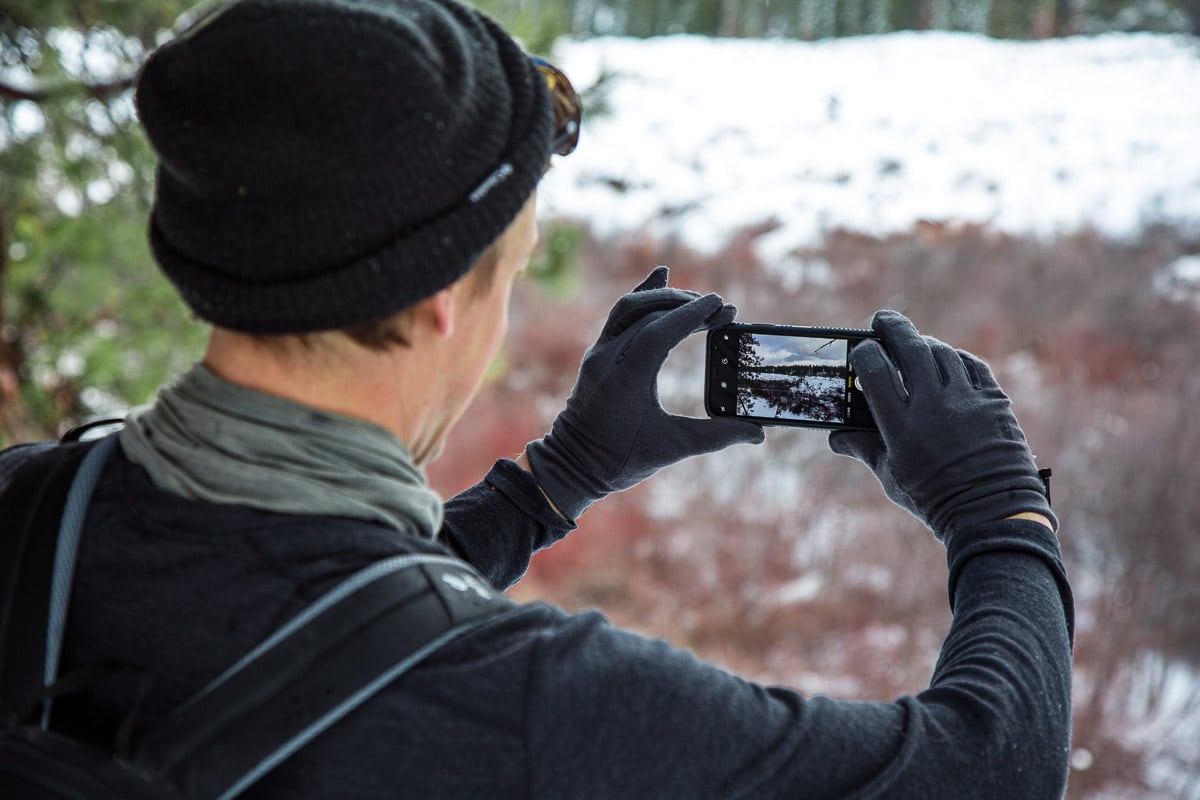
Accessories
Hat/beanie/headband: A cozy hat is a must for hiking in the winter. Michael prefers a lightweight beanie, while I go for a thermal headband to wear with a ponytail or braid.
Neck Gaiter/buff/scarf: A wool or synthetic gaiter traps warmth at your collar and can be pulled up over your nose for wind protection. Here’s our favorite.
Polarized sunglasses: A bluebird day might be great for a winter hike, but bright snow can be blinding. Michael’s go-to sunglasses have detachable side shields for glare; snug goggles work well in very cold or windy conditions.
Gloves/Mittens: You will absolutely want a pair of gloves when hiking in the cold! Here are my favorites, which are warm, low-bulk, touchscreen-compatible, and we pack waterproof mittens as an outer shell if needed.
Underwear: Choose underwear (including sports bras) that don’t contain any cotton.
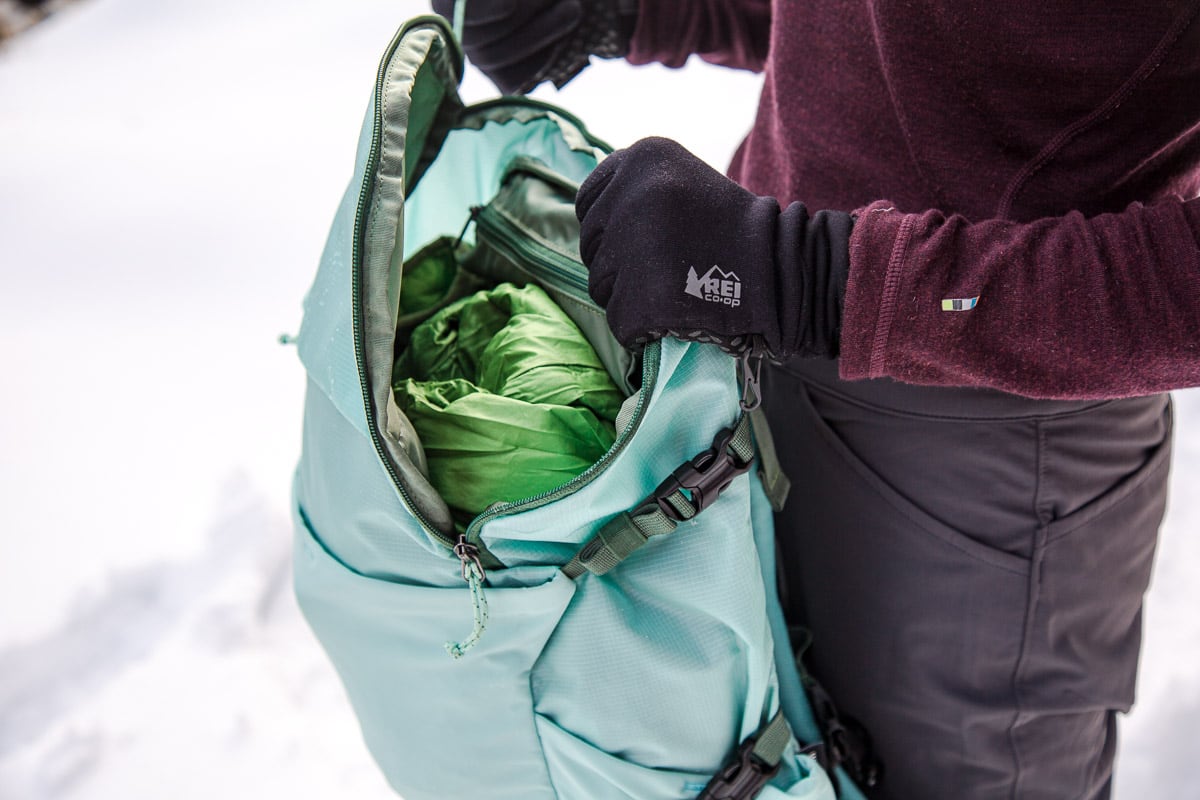
Essential gear for winter hikes
In addition to the layers we detailed above, here is the other winter hiking equipment that you’ll want to bring along:
Day Pack: You may need a larger daypack than for summer hikes to accommodate extra layers and your safety gear. Something like the Gregory Targhee is a good option and has exterior straps to accommodate snowshoes as well.
Water Bottle/Hydration System: Winter air is drying, and you’ll lose a lot of moisture through your breath, so drinking plenty of water is critical. This water reservoir features an insulated hose to help prevent freezing. Using a reservoir and hose system like this usually means you’re more likely to drink as you hike (since you don’t have to stop to grab a water bottle out of your pack).
Hiking Poles & Snow Baskets: Great for stability on snowy trails. We usually bring at least one pole each.
Sunscreen: Sunlight reflecting off snow can burn your skin quicker than on a hot day at the beach. Apply sunscreen to all exposed skin and reapply throughout your hike.
Lots of food: Winter hiking burns a lot more calories than summer day hiking. Additionally, your body’s metabolic furnace will help keep you warm on the trail—if you properly fuel it! Pack plenty of hiking snacks for your trip (more than you think you need), focusing on a mix of carbs (~60g/hour per hour) for quick energy and fats for sustained warmth.
Headlamp: A fully charged headlamp (or one with a spare set of batteries) is critical when hiking in winter since the days are short and the hiking can be slow. It’s already difficult to navigate in the snow—imagine doing it in the dark, too! Keep it in a warm pocket to prevent battery drain.
Navigation: Route finding when hiking in snow can be a real challenge, especially if the snowpack is high enough to cover signs and trail markers. Bring a navigation device you are already comfortable using—and then bring a backup! We load maps onto our phones using Gaia GPS or AllTrails+, AND print out a paper copy, stored in a plastic bag with a compass.
SOS/Communication Device: You may also want to consider a 2-way satellite communicator & SOS device like the Garmin inReach Mini, which allows emergency contact and SOS signaling without cell service.
First Aid + Repair Kit: Everything you need to fix you and your gear. We bring the same first aid kit that we would carry in summer, but we’ll add hand and toe warmers and a space blanket.
Fire: Pack a weatherproof firestarter, dry tinder, and/or a lightweight stove. Redundant fire-starting options are essential in case one fails.
Emergency Shelter: For our winter hikes, we pack these thermal emergency bivvys, which can be used in emergencies to retain body heat and block snow, rain, and wind.
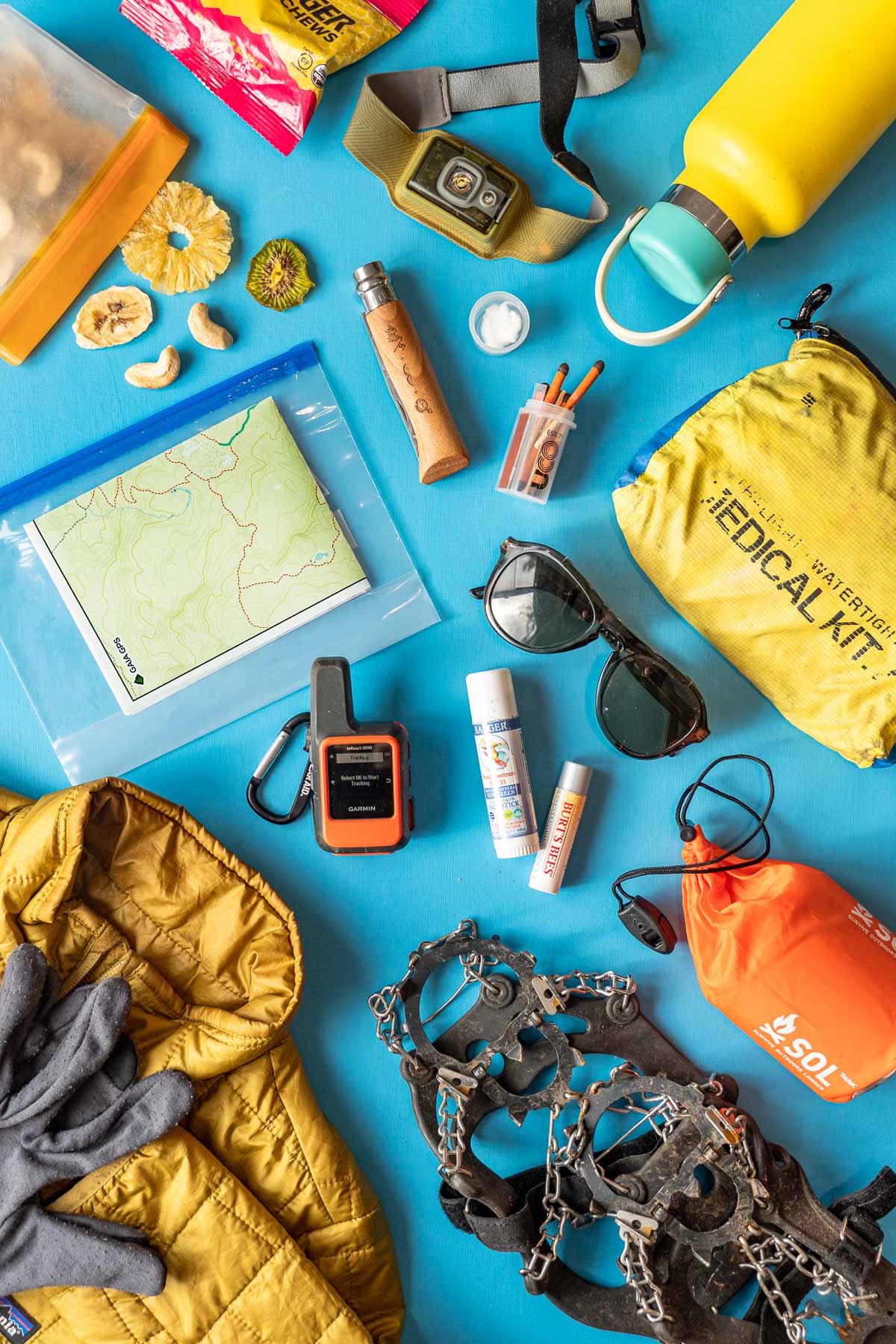
Winter hiking gear checklist
Worn Layers
Carried Gear
Navigation: map, compass, altimeter, GPS device, personal locator beacon (PLB) or satellite messenger
Headlamp: plus extra batteries
Sun protection: sunglasses, sun-protective clothes and sunscreen
First aid kit: including foot care
Knife: plus a gear repair kit
Fire: matches, lighter, tinder and/or stove
Shelter: carried at all times (can be a light emergency bivy)
Extra food: Beyond the minimum expectation
Extra water: Beyond the minimum expectation
Extra clothes: Beyond the minimum expectation
from REI.com
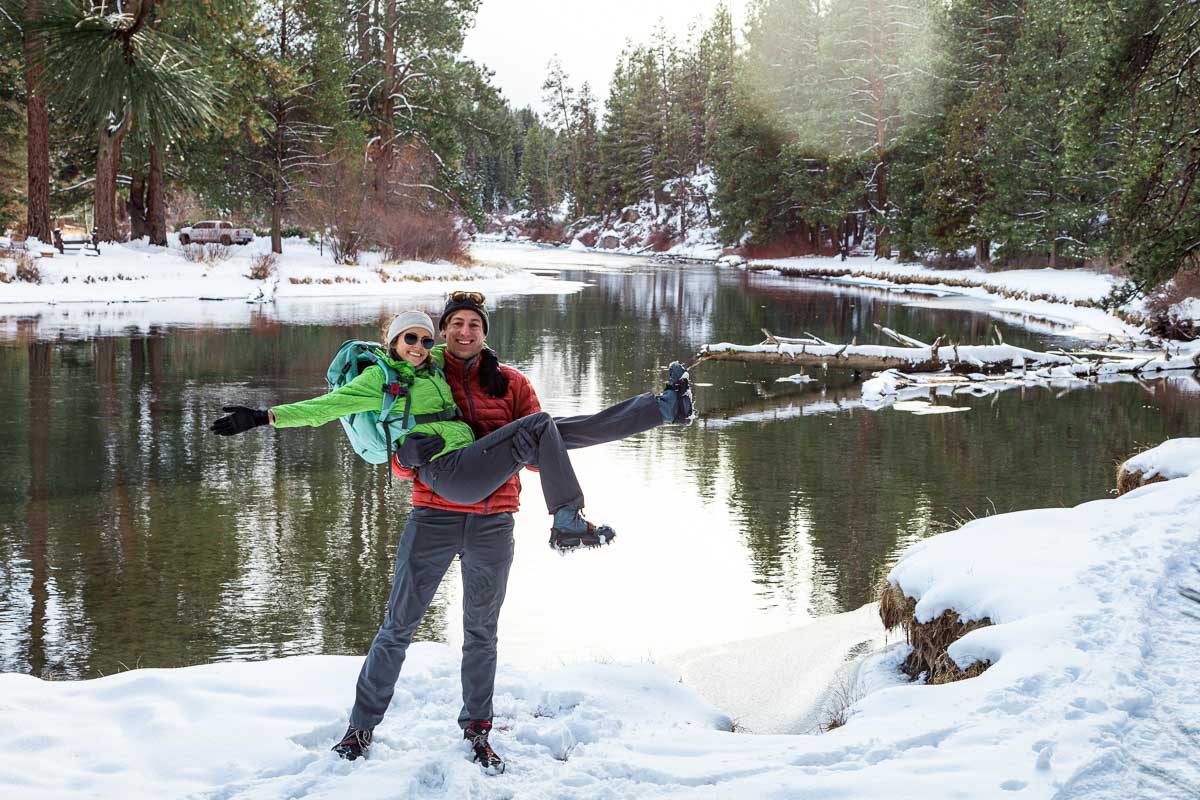
Read this next…
Before you head out, brush up on some of the skills you need for hiking in snow, including planning tips, safety considerations, and more tips for staying comfortable and having fun out there!

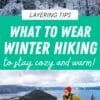
good advice.
Fantastic overview and recommendations. Thank you so much for putting this together and sharing with us!
Great rec on the smartwool baselayer leggings, Megan. I used an REI gift card from xmas, they arrived yesterday and are perfect. I was so pleased to get a baselayer that ISN’T black. You never know with these things, but after making a bunch of your recipes, I should have known you wouldn’t lead me astray. Keep up the good work.